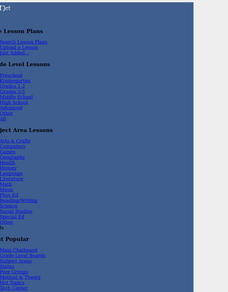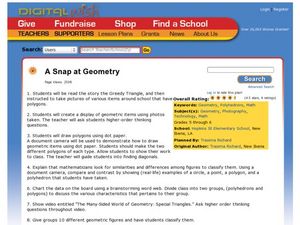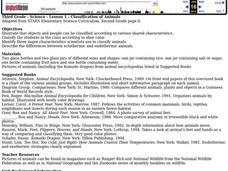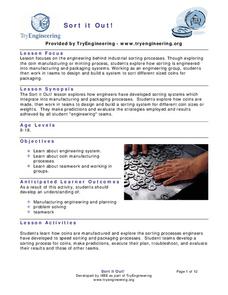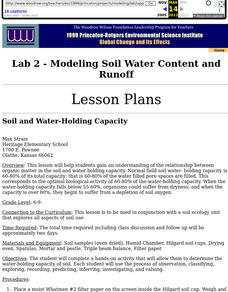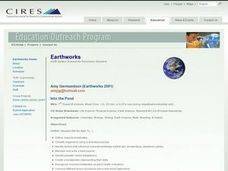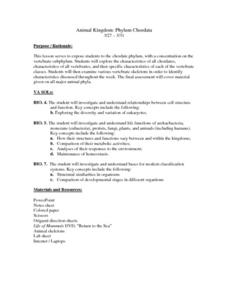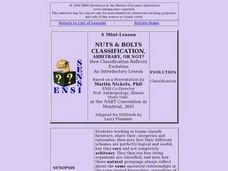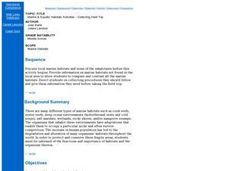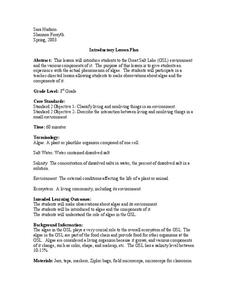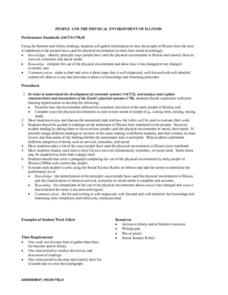Curated OER
Plant Life
Seventh graders examine different categories of plant life and their roles as producers of food and oxygen for other organisms. They study the evolution of plants from simple organisms to very complex ones. They look at the different...
Curated OER
Roles And Functions of Political Players
Young scholars name and classify political representatives in the Canadian Parliament. The roles and responsibilities of the political players are examined.
Curated OER
A World Of Matter
First graders complete a variety of experiments with solids, liquids and gases. They read books about matter, identify the characteristics of solids, liquids and gases and the sort and classify a variety of matter. Students make...
Curated OER
A Snap at Geometry
Students study geometric images and polyhedrons. In this geometry lesson plan, students complete several activities to learn about geometric shapes and classify polyhedrons from polygons. Students watch a video, complete a web-directed...
Curated OER
Classification of Animals
Third graders practice classiyfying items and identify three major characteristics scientists use to classify animals. They describe the differences between ectothermic and endothermic animals.
Curated OER
Sort It Out
Learners study classification systems by sorting Legos and determining how the different pieces are classified. They list as many attributes as possible to use for sorting.
Curated OER
Classification of Materials
Students classify photographs into a two-way classification system. They practice with pictures of people who are young and old, male and female, then they use pictures of animals to create their own two-way classification system.
Curated OER
Pesticide Prevalence
Young scholars investigate the prevalence of pesticides in their communities by
searching their homes, visiting local stores and talking to extended family and friends. They conduct their search by classifying pesticides based on the...
Curated OER
Permeability of Earth Materials
High schoolers observe and classify the permeability of a variety of materials.
Curated OER
Into the Pond
Seventh graders use a pond to explore macroinvertebrates and other organisms. They use a dichotomous key to classify the organisms and maintain a journal recording their findings.
Curated OER
Five Senses
Students listen to the book "My Five Senses." They work together to classify fifteen objects by the sense that they affect. They discuss the sense organs and complete a chart. Finally, they sort mystery items from a bag which the teacher...
Curated OER
Where Should We Place Archaeopteryx?
Students classify Archaeopteryx using pictures of actual fossils and scientist representations of how the animal might have looked. They compare Archaeopteryx's characteristics to those of the five extant vertebrate groups to...
Curated OER
Animal Kingdom: Phylum Chordata
Learners use a dichotomous key to classify various vertebrate jar speciments into classes. They examine the speciments for general characteristics of each class and fill in a corresponding chart and then complete a few final assessment...
Curated OER
Nuts & Bolts: is Classification, Arbitrary, Or Not?
Students, in groups, classify furniture, share their categories and rationales, then note how their different schemes vary, perfectly logical and useful, but completely arbitrary.
Curated OER
Collecting Field Trip
Students identify and describe each marine habitat. They name organisms that can be found in each habitat and discover ways in which to protect them. They participate in an activity to complete the lesson.
Curated OER
What is a Pest?
Students investigate whether rabbits should be considered pests even though they make good pets. They extend this to determine what, when, and where other organisms are considered to be pests, and examine why the concept of a pest is a...
Curated OER
Ecology: Adaptations
Eighth graders identify different types of adaptation in organisms. In this biology lesson, 8th graders explain how adaptation help organisms survive. They complete a worksheet at the end of the lesson.
Curated OER
Great Salt Lake
Third graders are introduced to the Great Salt Lake (GSL) environment and the various components of it. They make observations about algae and its environment and discuss why it is considered a living organism and various components of...
Curated OER
Choosing an Appropriate
Students use the classified ads of a local newspaper and read descriptions of people's goals, interests, experience, and skills, then find an appropriate employment ad for that person. Next, they find an appropriate ad for themselves.
Curated OER
Creative Classification
Students create an animal by using physical characteristics to classify that animal in the Linnaean Classification System. This lesson is part of a multi-segmented unit on the diversity of life.
Curated OER
People and the Physical Environment of Illinois
Students read about the settlement of Illinois from statehood to the present. They categorize different areas of need such as survival, economic and social. Students make a list of ways people used the physical environment in Illinois...
Curated OER
Invertebrate Classification
High schoolers discuss the recent disovery of the "furry lobster" to peak interest in the animal kingdom. They classify various speciments using invertebrate dichotomous keys, identifying major animal phyla and classes. Thy the complete...
Curated OER
Variation in Human Skin Color
Students classify themselves according to the six skin types. In this biology lesson, students explore the causes of human skin variation. They present their findings in class.



